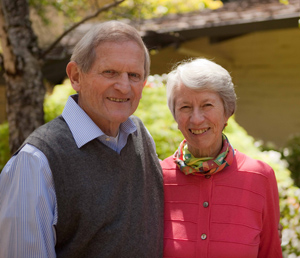May 7, 2012 - By Ruthann Richter

Slated to open in 2018, the hospital will replace aging facilities with the latest technology, bringing the medical center up to state seismic standards.
Stanford University President John Hennessy today announced the launch of a campaign to transform health care at a local, national and global level. The $1 billion Campaign for Stanford Medicine will make investments in medical research and teaching, build a new Stanford hospital and accelerate the translation of new medical knowledge into leading-edge, coordinated patient care.
The medical center is already halfway to its goal, with $500 million in pledges and expectancies from individuals and corporate donors.
The Campaign for Stanford Medicine will help fund the construction of a new hospital on the current Palo Alto site, combining the most innovative technologies with amenities to create a healing environment. The new hospital, which will replace aging facilities and bring the medical center up to state seismic standards, will be designed around four patient care pavilions.
Among the early supporters, three fundamental partners made gifts of $50 million each to ensure the successful launch of the Campaign for Stanford Medicine and the construction of the new Stanford Hospital. These gifts are from Tashia and John Morgridge, Anne and Robert Bass, and the Redlich family. For their support, the Morgridges and the Redlich family will each name a patient care pavilion.

John Hennessy
In addition, seven companies have committed $175 million for the project through the Stanford Hospital Corporate Partners initiative. These include founding members Apple, eBay, Hewlett-Packard, Intel, Intuit and Oracle, as well as NVIDIA, which joined the group in April.
“Providing the most advanced health care possible to people — locally, nationally and globally — will be one of the great challenges of this century,” Hennessy said. “The Campaign for Stanford Medicine draws upon our particular strengths — the proximity of the university to its hospitals and clinics — to focus on this issue and better serve the public. It will allow us to seek solutions to some of medicine’s most daunting problems, and it will begin in our own community with the new Stanford Hospital. With the early support of visionary and generous partners, and others who will join us in this venture, we will realize a new, transformative model of health care.”
The new hospital, on which construction will begin in 2013, will incorporate advanced technologies, such as state-of-the-art imaging equipment and new “hybrid” interventional platforms equipped for a variety of procedures, including surgeries and catheterizations. These flexible spaces will eliminate the need for separate patient prep and recovery areas for each type of procedure, and are expected to reduce infection risks and improve outcomes.
The hospital, a level-1 trauma center, also will increase its space for treating major traumatic injuries and offer greatly expanded emergency services for the community, with 59 treatment bays for patients. All patient rooms in the new hospital will be private and will be surrounded by gardens and views of the foothills. Designed by renowned architect Rafael Viñoly, the project encompasses 823,000 square feet of new construction and is scheduled to open in 2018.
The commitment from John and Tashia Morgridge emerged from the couple’s longstanding connections to Stanford. John Morgridge, former CEO of San Jose, Calif.-based Cisco Systems, received his MBA at the university and teaches at the Graduate School of Business. He has been a university trustee and is a member of the board of directors of Stanford Hospital. Tashia Morgridge, a retired special-education teacher, author and co-founder of the TOSA Foundation (a private foundation focusing on education), was a member of the board of directors of Lucile Packard Children’s Hospital and was a 2003 recipient of Stanford’s Outstanding Achievement Award for her volunteer service to the community.
Once a patient at Stanford Hospital, John Morgridge said he began to realize the quality of the hospital’s infrastructure, which originated in 1959, did not match the high quality of its care. He also envisioned the medical center’s enormous potential to lead the way in health care, with its unique research talents and its ties to Silicon Valley.

“It is a combination of the unique capabilities of the valley, combined with the unique, broad capabilities of Stanford and a very strong medical research and teaching and translational hospital,” he said. “You need all of those if you’re going to take on the global issue of health care, and I think this is an opportunity to do that.”
Christopher Redlich, a 1972 Stanford graduate, said he and his family chose to support the hospital because he has come to see it as the ideal vehicle for his vision of a transformed health-care system. Redlich is the former chair of Marine Terminals Corp., which has interests in ports, marine terminals, stevedoring, warehousing, industrial maintenance, leasing, insurance underwriting and software development. After he retired in 2007, he said he began searching for an area of interest and settled on medicine.

John and Tashia Morgridge say their gift to the medical center stems in part from their longtime connections to Stanford.
He met Mariann Byerwalter, chair of the hospital’s board of directors, who introduced him to the people and programs at the medical center, which left him greatly impressed. He began to imagine a system of seamless care, provided in a comfortable, welcoming environment.
Just as he streamlined the shipping business while maintaining excellent customer service, Redlich said he sees the hospital as leading the way in transforming health-care delivery and reducing health-care costs while offering new technological solutions to medical problems.
“I’ve made my gift to the new Stanford Hospital because it is the first link in a very long chain of events that will lead to the improvement of medicine in this country,” Redlich said. “By putting this hospital in this location, in this university, we will be able to attract the best people, we’ll be able to provide the best medical services, and we’ll be able to adjust and adapt as medicine changes throughout time.”
Robert Bass received a Stanford MBA in 1974, and Anne Bass received a master’s of liberal arts from Stanford in 2007. The couple has been deeply involved with Stanford for decades. Robert Bass has served as member and former chair of the Stanford Board of Trustees and as a director of the Stanford Management Company. He is president of Keystone Group LP, founder of the Oak Hill family of investment funds, and chairman of the Aerion Corp. Anne Bass has served on the board of directors for Packard Children’s Hospital and the Lucile Packard Foundation for Children’s Health. She is a nationally recognized civic volunteer, known for her dedication to children’s issues, education, historic preservation and land use.

Christopher Redlich and his family say they want their gift to help promote change in the health-care system.
While a major portion of the campaign — $700 million — will support the new hospital, the remaining $300 million will fund a number of important initiatives in the School of Medicine that will transform the delivery of care and advance innovation and discovery.
Among the major gifts for research is a new $10 million commitment from the Canary Foundation for research to improve early detection of cancer. The nonprofit, founded and chaired by Donald Listwin, has committed $28 million to date to the School of Medicine for new diagnostics and molecular imaging tools to locate and confirm the presence of tumors.
The campaign funds also will support efforts to revamp medical education while enhancing other graduate education programs in the biomedical sciences.
The campaign co-chairs are John Levin (AM ’70, JD ’73); Mariann Byerwalter (AB ’82); John (AB ’59, LLB ’63) and Jill Freidenrich; and Ron (AB ’80) and Karen Johnson.
A parallel fundraising campaign, “Breaking New Ground,” continues to support the child health programs of the School of Medicine and a transformative expansion of Lucile Packard Children’s Hospital. The children’s hospital eventually will double in size, adding 150 private patient rooms and new family-friendly surgical, diagnostic and treatment areas. Campaign funds also will be applied to training the next generation of pediatric leaders and discovering new cures for childhood diseases.
About Stanford Medicine
Stanford Medicine is an integrated academic health system comprising the Stanford School of Medicine and adult and pediatric health care delivery systems. Together, they harness the full potential of biomedicine through collaborative research, education and clinical care for patients. For more information, please visit med.stanford.edu.